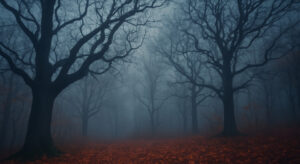
Nature’s Spooky Side: Through An Arborist’s Lens
As the days grow shorter and the leaves fall, even the most familiar trees start to look a little spooky. Bare branches twist in the moonlight, shadows dance across the ground, and the creak of an old oak can sound downright ghostly. But sometimes, what seems eerie has a fascinating story or a scientific explanation behind it.
At Titan Tree Care, we love this time of year. It’s when we get to appreciate the beauty, mystery, and resilience of the trees around us and help homeowners understand what’s really going on behind those “haunted” looks.
“Creepy” Tree Features: Through an Arborist’s Lens
Ever wonder why some trees just look spooky? Many of the features that give trees a haunted look are actually signs of natural aging or decay:
- Hollow trunks and cavities: These dark spaces make trees look mysterious but often signal internal decay or wood rot.
- Mushrooms or shelf fungi: Those bracket-like growths on trunks or roots aren’t decorations — they’re fruiting bodies of fungi feeding on the wood inside.
- Gnarled, twisted limbs: Years of wind stress, pruning, and growth toward sunlight shape trees into dramatic, sculptural forms.
- Cracks or peeling bark: These can occur naturally but may also indicate structural weakness or disease.
Arborist Tip: If your tree’s “spooky” look includes mushrooms, deep cracks, or hollow sections, it’s worth scheduling a professional tree inspection before fall storms roll through.
October Tree Health & Safety Tips
Fall is the perfect time to check your trees before winter weather sets in. As leaves drop, hidden problems become easier to spot.
Here’s what to look for:
- Dead branches or “snags” that could break in high winds.
- Fungal growths or mushrooms at the base of the trunk.
- Cracks or splits in large limbs.
- Signs of rot or cavities near the base.
When to call an arborist:
- If you notice hanging or weakened branches near your home.
- When large mushrooms or conks appear on your trunk or roots.
- After a heavy storm to assess potential hazards.
Fall Tree Care Tips:
- Mulch around the base to retain moisture and protect roots.
- Avoid damaging bark with mowers or trimmers.
- Delay heavy pruning until trees are fully dormant in winter — but remove dangerous limbs now.
Creature Feature: Nature’s Spooky Side
Many of the “creepy” sights and sounds we associate with October are signs of healthy ecosystems.
- Bats and owls often roost in hollow trees and are nature’s pest control working the night shift!
- Squirrels and raccoons take shelter in decayed limbs or old cavities.
- Fungi and insects play vital roles in decomposition, breaking down old wood to enrich the soil.
Even the most hauntingly beautiful dead tree, called a “snag”, can provide habitat for dozens of wildlife species. So before you label a tree “scary,” remember it may be home to a hidden world of life.
From Spooky to Safe: Why Tree Inspections Matter
Whether your trees are centuries old or recently planted, it’s important to keep an eye on their health, especially before winter storms hit. What may look like a charmingly “haunted” branch could be a real hazard in high winds.
At Titan Tree Care, we provide professional tree assessments throughout Virginia, Maryland, and Washington D.C. Our certified arborists can identify potential risks, spot decay or disease early, and help keep your property (and your spooky trees) safe year-round.
Final Thought
The next time you walk outside on a crisp October evening and hear the whisper of wind through the branches take a closer look. Behind every “spooky” tree is a story, a bit of science, and sometimes a sign that it’s time to call your friendly neighborhood arborist.
Get a Quote
Looking for expert tree care? Fill out the form below and we’ll be in touch!
Looking for expert tree care?

